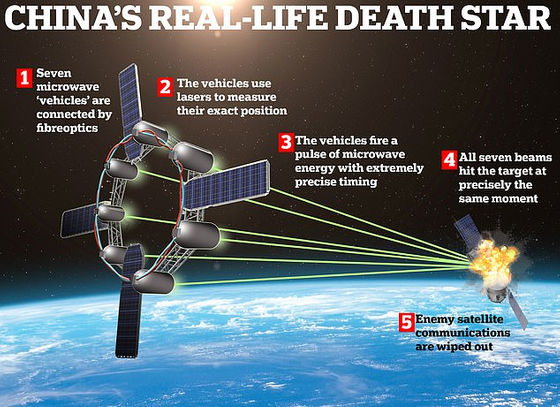Chinese scientists say they've developed a Death Star-inspired focused beam weapon

The
Chinese scientists say they have made converged energy beam weapon a reality | South China Morning Post
https://www.scmp.com/news/china/science/article/3284794/chinese-scientists-say-they-have-made-converged-energy-beam-weapon-reality
Chinese scientists claim they have built a Death Star-inspired beam weapon | Live Science
https://www.livescience.com/technology/engineering/chinese-scientists-claim-they-have-built-a-death-star-inspired-beam-weapon
Chinese scientists have built a 'real-life DEATH STAR': Terriifying Star Wars-inspired weapon focuses microwave beams to wipe out enemy satellites | Daily Mail Online
https://www.dailymail.co.uk/sciencetech/article-14048299/Chinese-scientists-build-DEATH-STAR.html
China's new beam weapon is reportedly 'a new type of high-power microwave weapon that combines electromagnetic waves and ultra-precise timing technology.'
The weapon, which has already passed the testing hurdles that would make it suitable for military use, is made up of multiple microwave transmitters placed in different locations, just like the Death Star in Star Wars, which has eight laser cannons positioned around a gigantic space station and focused into a single laser beam.
To achieve this, the position error of each microwave transmitting device must be kept to less than 1 millimeter, and the synchronization error between the devices must be kept to 170 picoseconds (1 picosecond is 1 trillionth of a second).
Chinese engineers claim they have created a system that uses 'ultra-precise time synchronization' through timing devices connected by fiber optics, and seven microwave transmitters to attack a single target, resulting in a 'combined effect of 1 + 1]2' - a destructive force greater than the simple sum of the individual lasers.

While this power is not as destructive as the Death Star's planet-shattering laser, just 1 gigawatt of power is enough to cause serious damage to an orbiting satellite.
After confirming that the weapon could effectively suppress communications from US GPS and other satellites, the engineers concluded that a focused beam weapon 'could achieve multiple purposes, including education and training, testing of new technologies and military exercises.'
Drones have been shown to play a major role in modern warfare, such as Russia's invasion of Ukraine, and military organizations around the world are turning to lasers as a means of intercepting drones and hypersonic missiles.
The US Navy announced that it had successfully tested a laser beam to shoot down a drone from a warship - GIGAZINE

But some say this sci-fi weapon might be too difficult to actually put into production: According to science news site Live Science, the microwaves are extremely narrow energy beams that would need to be precisely aligned and focused, and their firing would need to be timed to within a millionth of a second.
In addition, the Beidou satellite navigation system , known as China's version of GPS, can determine positioning with an accuracy of less than one centimeter, but the new weapon announced this time must be able to determine its position with an accuracy of within one millimeter, as mentioned above.
Microwaves also become ineffective over long distances because they are scattered by dust and moisture in the atmosphere. This can be overcome by increasing the power of the microwaves, but no batteries yet exist that can deliver that much energy.
From this point of view, Live Science commented, 'It is likely that the Chinese research team could have realized a converged microwave weapon system in a controlled environment. But the real world is much more complex than a lab environment, so any technology that requires such high precision would pose significant challenges.'
Related Posts:
in Science, , Posted by log1l_ks







